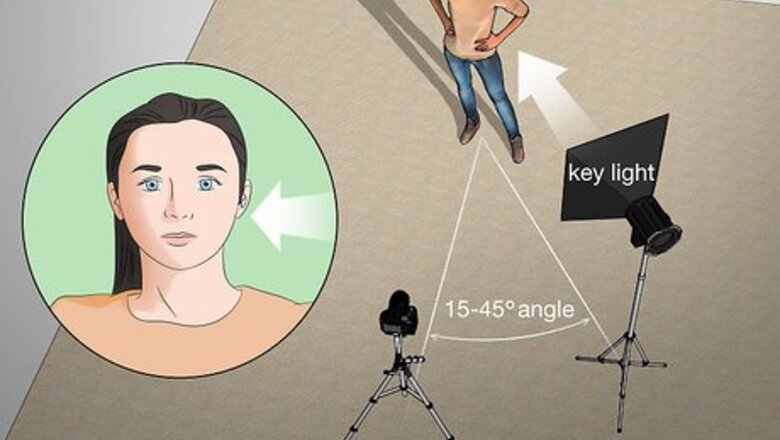
views
X
Expert Source
Crystal BearProfessional Photographer
Expert Interview. 21 January 2021.
The key light illuminates the subject directly, the fill light softens the harsh shadows created by the key light, and the back light provides illumination around the edges of the subject to make them stand out. To get the right three point lighting configuration, set up your lights with the fill and key lights next to the camera and the back light behind your subject. You’ll also need to pick the right equipment for you based on your needs and budget. Then, you can start to manipulate the individual lights to produce incredible effects!
Arranging Your Lights
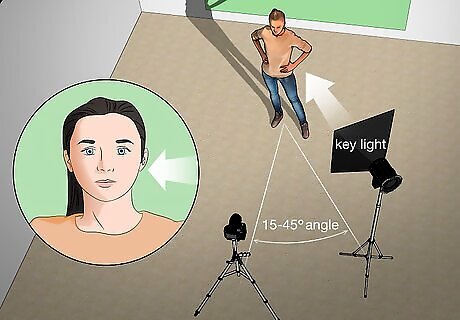
Set up your key light next to the lens on your camera. The key light is the main source of light in a three point setup. It determines the main contrast between light and shadow on your subject. Place your first light near or slightly above eye level with your subject. Move it so that it’s near the left or right of the camera, forming a 15-45 degree angle with the subject.Tip: Deciding between putting your key light to the left or right of your camera is as simple as determining where you want the shadows to fall. If the key light is to the left of the camera, the shadows will fall on the right and vice versa. If your camera and key light form an angle thinner than 15 degrees with your subject, they will get washed out in light. Set up your key light first. It’s your main source of light in a shot, and will make it easier to see how the fill light changes the shadows created by your key light.
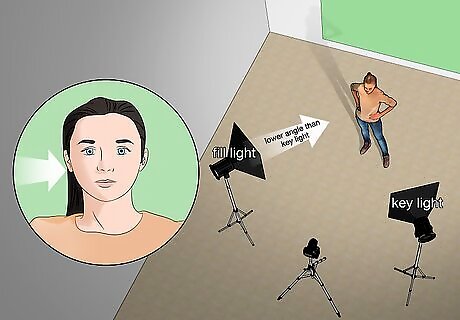
Arrange your fill light on the opposite side of your key light. The fill light will soften the sharp contrasts created by your key light by adding a softer light source on the opposite side of your key light. If your key light is on the far left of the camera, put your fill on the near right; if your key light is on the near right, put the fill on the far left. Place your fill light at an angle lower than your key light to ensure that you don’t flood the features of your subject with 2 light sources from the same angle. In natural environments, light is reflected off of certain surfaces, creating the illusion that there are multiple sources of light. Fill lights replicate this effect and make your subject look more natural.
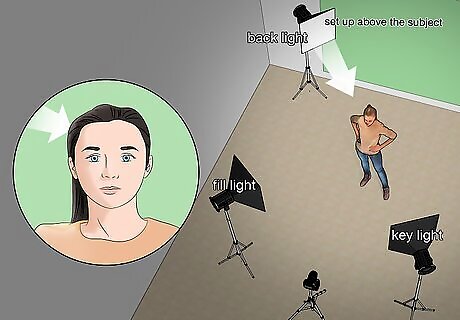
Place your back light behind and above your subject. The back light’s job is to separate the subject that you’re shooting from the background by placing a layer of light on top of the subject to make them stand out. Set up your back light so that it sits above and behind your subject, out of view of your camera. Moving the back light slightly to the left or right of the subject will create a greater contrast between light and shadow above your subject. The back light is often referred to as the rim, hair, or shoulder light. Set up your back light last. Its effect is largely dependent on where your key and fill lights are placed.
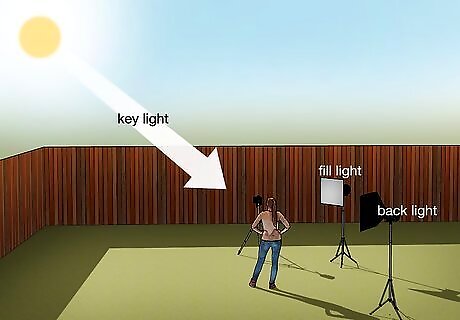
Use the sun to replace your key light for a natural look. If you’re shooting outdoors, the sun will present a natural light source that you need to account for. To create a natural look, use the sun to replace the key light in your photo. Set the fill light on the opposite side of the sun near your camera to remove unflattering shadows. Use your back light to generate a glow around your subject to make them stand out. The sun will serve as your key light. You can use the sun to replace your back light if it’s high in the sky and you want your subject to stand out more.
Using the Right Equipment
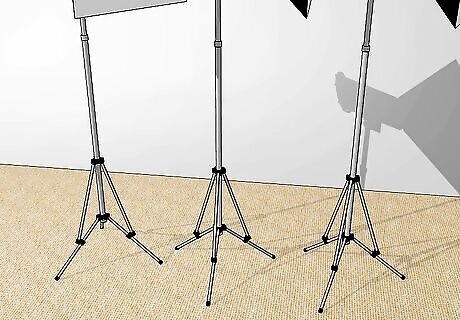
Get 3 adjustable light stands for your lighting kit. You need stands to hold and adjust each light in your setup. Look for stable tripods that are specifically designed for lighting so that you can attach softboxes, bulbs, and umbrellas. There are lighting kits that you can buy that come with 3 light stands that are specifically sized for three point lighting.
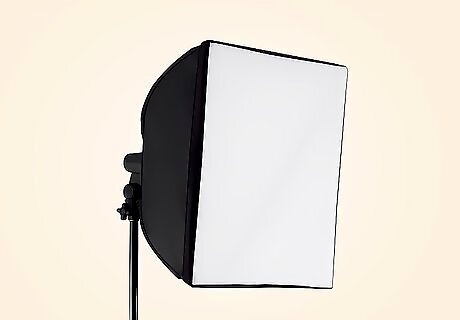
Use softboxes for more control of your lighting. Softboxes are rectangular boxes filled with reflectors that diffuse light to generate a range of shadows without harsh, direct light. Softboxes are the most commonly-used lighting equipment in photography and film because they offer a lot of control over the light source and do a good job of emulating natural light. Softboxes tend to be more expensive than umbrella lighting, but they provide a lot of freedom when it comes to setting up and adjusting your lights. Softboxes are mounted by screwing them in to the top of a light stand.
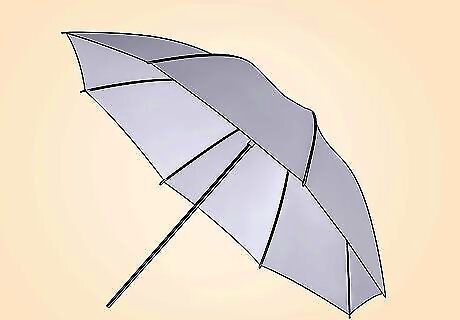
Opt for umbrella lighting if you want a portable option. Umbrella lights filter your light source through a translucent umbrella in order to remove harsher tones and generate clear transitions from light to dark. Use umbrella lights if you frequently shoot at different locations and need to be able to pack your equipment up quickly. To set up an umbrella light, look for a small, circular opening just below the light stand. Thread the umbrella’s rod through this hole to attach it to your stand. Umbrella lighting tends to be cheaper than softbox light kits because it doesn’t tend to have as much power or customization.
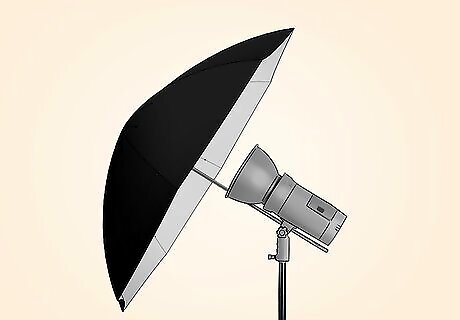
Attach strobe lights if you need power or shoot in a studio. Strobe lights are a light source that you attach to your softbox or umbrella to produce light. They’re large bulbs that serve as a flash that fires away from your camera. They tend to be bulkier and more powerful than speedlights, so choose a strobe if you need strong lighting and don’t plan on moving your camera out of a studio. Strobe lights are often called monolights, because they often only use a single bulb.
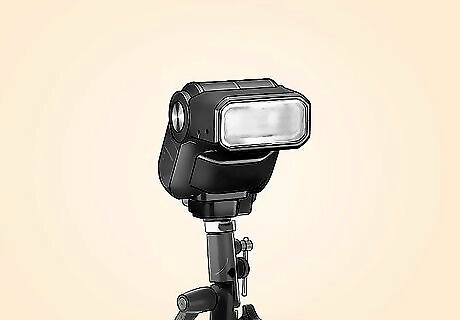
Go for speedlights if you plan on shooting in different locations. Speedlights are a light source that go into your softbox or umbrella lighting setup to create light. They tend to be smaller than strobes and are easier to set up, although they generally aren’t as powerful. Use speedlights if you want the freedom to move your equipment around and don’t need a ton of power. Speedlights tend to be cheaper than strobe lights since they’re weaker than strobes. Most speedlights come with an automatic mode that makes basic lighting settings easy.
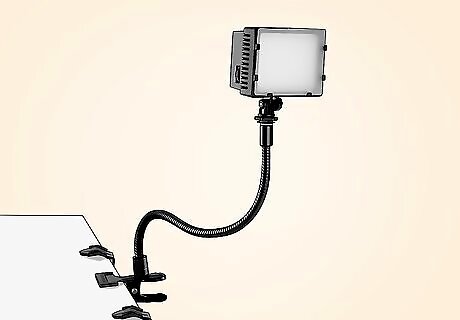
Use a household lamp or clamp light for a continuous light set up. You can easily set up a simple three point configuration with household LED or CFL bulbs. You can use a household lamp or attach a clamp light to your light stand by looping the clamp over the top of your tripod. If you don’t need a fancy lighting set up, there’s nothing wrong with using simple household bulbs and equipment.Tip: Continuous light has the added benefit of making it easy to see how your subject will look under certain conditions, since you aren’t turning the lights on and off when you’re shooting. If you’re just starting out, consider using simple continuous light to get used to setting up a three point lighting configuration.
Adjusting Lights to Create Specific Effects
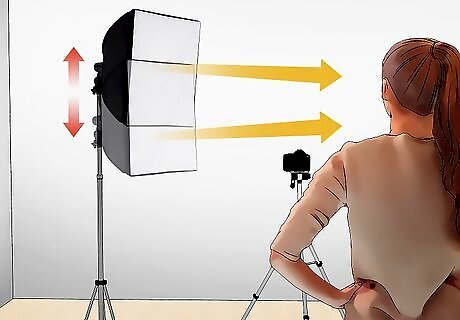
Adjust the height and position of your lights to change the shadows. The position of each individual light will influence how shadow and light spreads across your subject. When setting up your three point lighting, adjust the height and position of your lights until you have a setup you’re happy with. Start by adjusting your key light first and your back light last to ensure that you’re moving lights in order from most influential to least adjustable. To adjust a light, either manually turn the power of the bulb down, use a thicker umbrella or softbox, or adjust the strength of your light on the light’s control unit. How you adjust your lights depends on your specific brand of lighting equipment. If you’re using a basic lighting set up with lamps and simple LED lights, you can’t adjust them. However, you can move a light source away or towards your subject to change the intensity of the light.
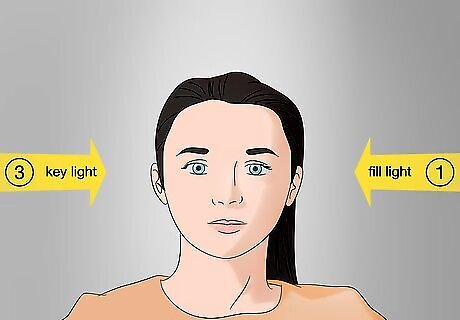
Choose a low key-to-fill ratio to soften shadows on your subject. A key-to-fill ratio of 3:1 or 2:1 will wash your subject in light and greatly cut down on the darkness of the shadows in your shot. This has the effect of making your composition feel more colorful, since the color values will have access to more light. Depending on your subject, it can make your image look cheerful or bright. The numbers in a key-to-fill ratio refer to the intensity of the light as it’s measured by a light meter. These numbers are almost always listed on the control unit for a light source, so it’s usually as simple as turning the knob to “3” on your key light and “1” on your fill light for a 3:1 ratio.
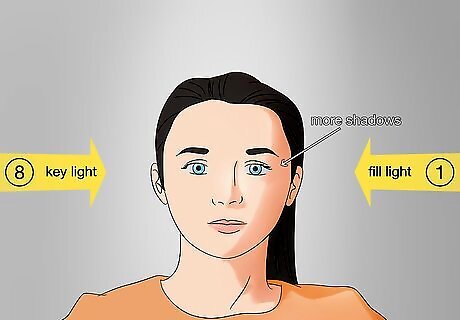
Use a high key-to-fill ratio to create more shadows. A key-to-fill ratio of 8:1 or higher will increase the contrast between light and shadow in your image. This can make an image or scene appear more dramatic or ominous. It can also be used to replicate the look of night time when the moon or a streetlight is the only light source around.Tip: Harsh lighting can look unnatural if it’s not set up correctly. Take a couple of test shots after setting up a high key-to-fill ratio to see if you need to make any adjustments.
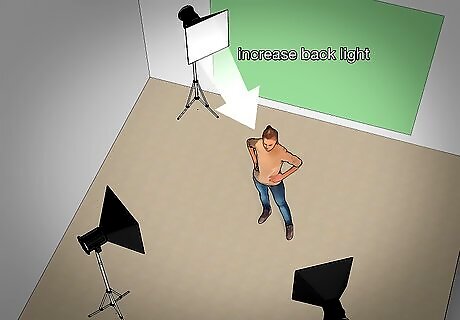
Opt for a strong back light if you’re shooting video. When it comes to moving images, a strong back light is essential for catching your viewer’s eye and keeping their attention. The absence of a back light can make your subject look flat against the background and make it hard for a viewer to watch for long periods of time. Turn your back light up a little higher and consider removing an umbrella or softbox to generate moving images that are easily followed by a viewer. You’re more likely to hear a back light called a hair light on film shoots.












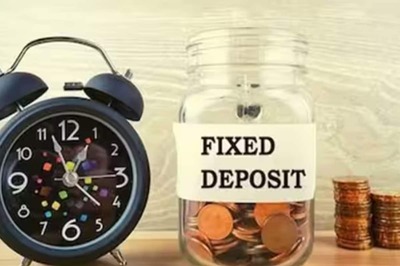



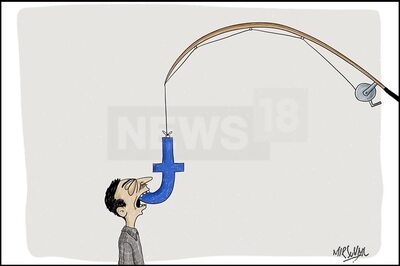

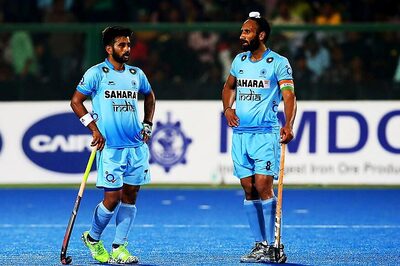

Comments
0 comment